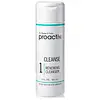What's inside
What's inside
 Key Ingredients
Key Ingredients

 Benefits
Benefits

 Concerns
Concerns

 Ingredients Side-by-side
Ingredients Side-by-side

Benzoyl Peroxide 2.5%
Water
Skin ConditioningMagnesium Aluminum Silicate
AbsorbentGlyceryl Stearate
EmollientPEG-100 Stearate
Sorbitol
HumectantDimethyl Isosorbide
SolventDisodium PEG-12 Dimethicone Sulfosuccinate
CleansingTridecyl Stearate
EmollientNeopentyl Glycol Dicaprylate/Dicaprate
EmollientParaffin
PerfumingCetyl Esters
EmollientAnthemis Nobilis Flower Extract
MaskingTridecyl Trimellitate
EmollientTrisodium Sulfosuccinate
BufferingPEG-12 Dimethicone
Skin ConditioningSodium Sulfate
Sodium Hyaluronate
HumectantPropylene Glycol
HumectantSodium PCA
HumectantXanthan Gum
EmulsifyingPhenoxyethanol
PreservativeImidazolidinyl Urea
PreservativeMethylparaben
PreservativePropylparaben
PreservativeParfum
MaskingBenzoyl Peroxide 2.5%, Water, Magnesium Aluminum Silicate, Glyceryl Stearate, PEG-100 Stearate, Sorbitol, Dimethyl Isosorbide, Disodium PEG-12 Dimethicone Sulfosuccinate, Tridecyl Stearate, Neopentyl Glycol Dicaprylate/Dicaprate, Paraffin, Cetyl Esters, Anthemis Nobilis Flower Extract, Tridecyl Trimellitate, Trisodium Sulfosuccinate, PEG-12 Dimethicone, Sodium Sulfate, Sodium Hyaluronate, Propylene Glycol, Sodium PCA, Xanthan Gum, Phenoxyethanol, Imidazolidinyl Urea, Methylparaben, Propylparaben, Parfum
Water
Skin ConditioningStearyl Alcohol
EmollientCetyl Alcohol
EmollientDisodium Lauryl Sulfosuccinate
CleansingGlyceryl Stearate
EmollientPropylene Glycol
HumectantPropanediol
SolventCocamidopropyl Betaine
CleansingPhenoxyethanol
PreservativeParfum
MaskingBenzyl Alcohol
PerfumingSodium Polyacrylate
AbsorbentSodium Chloride
MaskingTocopheryl Acetate
AntioxidantSodium Gluconate
Skin ConditioningSodium Metabisulfite
AntioxidantRubus Idaeus Seed Oil
EmollientPolypodium Vulgare Rhizome Extract
HumectantDehydroacetic Acid
PreservativeCetraria Islandica Thallus Extract
HumectantSphagnum Magellanicum Extract
Skin ConditioningRosa Moschata Seed Oil
EmollientCannabis Sativa Seed Oil
EmollientSodium Hydroxide
BufferingBakuchiol
AntimicrobialGlycerin
HumectantOlive Oil Polyglyceryl-6 Esters
EmollientCitric Acid
BufferingPolyglyceryl-6 Laurate
EmulsifyingCannabidiol - Synthetically Produced
AntioxidantUrtica Dioica Leaf Extract
Skin ConditioningMagnolol
AntioxidantHonokiol
AntioxidantHelianthus Annuus Seed Oil
EmollientRosmarinus Officinalis Leaf Extract
AntimicrobialPotassium Sorbate
PreservativeSodium Benzoate
MaskingLimonene
PerfumingWater, Stearyl Alcohol, Cetyl Alcohol, Disodium Lauryl Sulfosuccinate, Glyceryl Stearate, Propylene Glycol, Propanediol, Cocamidopropyl Betaine, Phenoxyethanol, Parfum, Benzyl Alcohol, Sodium Polyacrylate, Sodium Chloride, Tocopheryl Acetate, Sodium Gluconate, Sodium Metabisulfite, Rubus Idaeus Seed Oil, Polypodium Vulgare Rhizome Extract, Dehydroacetic Acid, Cetraria Islandica Thallus Extract, Sphagnum Magellanicum Extract, Rosa Moschata Seed Oil, Cannabis Sativa Seed Oil, Sodium Hydroxide, Bakuchiol, Glycerin, Olive Oil Polyglyceryl-6 Esters, Citric Acid, Polyglyceryl-6 Laurate, Cannabidiol - Synthetically Produced, Urtica Dioica Leaf Extract, Magnolol, Honokiol, Helianthus Annuus Seed Oil, Rosmarinus Officinalis Leaf Extract, Potassium Sorbate, Sodium Benzoate, Limonene
 Reviews
Reviews

Ingredients Explained
These ingredients are found in both products.
Ingredients higher up in an ingredient list are typically present in a larger amount.
Glyceryl Stearate is a mix of glycerin and stearic acid.
It is used to stabilize the mixing of water and oil ingredients. By preventing these ingredients from separating, it can help elongate shelf life. It can also help thicken the product's texture.
As an emollient, it helps soften skin and supports barrier-replenishing ingredients.
In cosmetics, Glyceryl Stearate is often made from vegetable oils or synthetically produced.
This ingredient may not be fungal-acne safe
Fun fact: The human body also creates Glyceryl Stearate naturally.
Learn more about Glyceryl StearateParfum is a catch-all term for an ingredient or more that is used to give a scent to products.
Also called "fragrance", this ingredient can be a blend of hundreds of chemicals or plant oils. This means every product with "fragrance" or "parfum" in the ingredients list is a different mixture.
For instance, Habanolide is a proprietary trade name for a specific aroma chemical. When used as a fragrance ingredient in cosmetics, most aroma chemicals fall under the broad labeling category of “FRAGRANCE” or “PARFUM” according to EU and US regulations.
The term 'parfum' or 'fragrance' is not regulated in many countries. In many cases, it is up to the brand to define this term.
For instance, many brands choose to label themselves as "fragrance-free" because they are not using synthetic fragrances. However, their products may still contain ingredients such as essential oils that are considered a fragrance by INCI standards.
One example is Calendula flower extract. Calendula is an essential oil that still imparts a scent or 'fragrance'.
Depending on the blend, the ingredients in the mixture can cause allergies and sensitivities on the skin. Some ingredients that are known EU allergens include linalool and citronellol.
Parfum can also be used to mask or cover an unpleasant scent.
The bottom line is: not all fragrances/parfum/ingredients are created equally. If you are worried about fragrances, we recommend taking a closer look at an ingredient. And of course, we always recommend speaking with a professional.
Learn more about ParfumPhenoxyethanol is a preservative that has germicide, antimicrobial, and aromatic properties. Studies show that phenoxyethanol can prevent microbial growth. By itself, it has a scent that is similar to that of a rose.
It's often used in formulations along with Caprylyl Glycol to preserve the shelf life of products.
Propylene Glycol is an odorless, colorless liquid. As a humectant, it helps skin retain moisture. It also aids in delivering active ingredients.
Another role of this ingredient is preventing a product from melting or freezing. Propylene glycol also adds antimicrobrial properties to a product, elongating product lifespan.
This ingredient is considered an organic alcohol and commonly added into both cosmetics and foods.
Those with sensitive skin or conditions may develop a rash when using this ingredient.
Learn more about Propylene GlycolWater. It's the most common cosmetic ingredient of all. You'll usually see it at the top of ingredient lists, meaning that it makes up the largest part of the product.
So why is it so popular? Water most often acts as a solvent - this means that it helps dissolve other ingredients into the formulation.
You'll also recognize water as that liquid we all need to stay alive. If you see this, drink a glass of water. Stay hydrated!
Learn more about Water